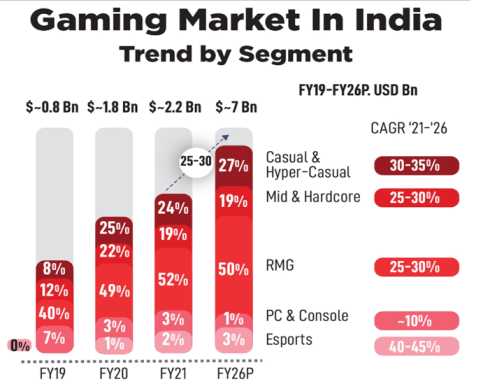
The rise of India’s gaming industry has been fueled by factors like increased smartphone adoption, affordable mobile data, and a growing audience. The market size is projected to reach USD 3.49 billion in 2024, with a CAGR of 15.68%, and is expected to grow to USD 7.24 billion by 2029. The industry has seen a surge in localised content, esports, and community-building through online multiplayer games. Despite challenges like a 28% GST on gaming entry fees, the sector continues to attract investments and create job opportunities, with the online gaming market reaching INR 16,428 crore in FY23 and expected to enable 250,000 jobs by 2025. Key players in the Indian gaming market include Sony Corporation, Nintendo, Microsoft, and Electronic Arts Inc. The sector’s growth is also supported by regulatory guidelines and advancements in technology like AR and VR, shaping the future of gaming in India.
The Pandemic’s Impact on Indian Gaming Industry
The pandemic significantly impacted India’s gaming industry, leading to a surge in online gaming as people sought digital entertainment during lockdowns. This trend was evident in the increased number of gamers, game downloads, and time spent on gaming platforms. The average time spent on online games by Indians rose from 2.1 hours per week before the lockdown to 4.5 hours per week within a month of the lockdown, indicating a substantial shift towards gaming as a primary form of entertainment. The number of gamers in India rose to 390 million in 2021 from 278 million three years prior, showcasing a significant increase in the gaming audience. This growth was further fueled by factors like improved internet connectivity, a growing youth population, and the development of local gaming content.
Moreover, the pandemic-induced surge in online gaming translated into a substantial increase in revenue for the Indian gaming industry. The total revenue from games, including transaction-based games, esports, and casual games, is projected to increase by almost 50% through the end of 2024. In the first nine months of 2021 alone, the industry saw a significant investment influx, with venture capital funding touching $1.6 billion, surpassing the total investment figure in the previous five years. The ad spends by the gaming sector also witnessed a notable growth rate, reaching about Rs 1,270 crores in 2021, up from Rs 800 crore in 2020.

Overall, the pandemic not only accelerated the growth of India’s gaming industry but also attracted substantial investments, highlighted by the involvement of marquee VC firms and the rapid expansion of online gaming startups. The sector’s resilience and adaptability during the pandemic underscore its potential for further growth and economic impact, with the industry expected to create significant job opportunities and continue to shape the digital entertainment landscape in India.
During the pandemic, several factors contributed to the significant growth of India’s gaming industry. These include:
- Increased User Engagement: With lockdowns and restrictions in place, more people turned to online gaming as a primary form of entertainment, leading to a surge in user engagement across various gaming platforms.
- Rise in Online Gaming Traffic: The pandemic-induced lockdowns resulted in a substantial increase in online gaming traffic, with platforms like WinZo Games and Paytm First Games reporting significant spikes in user engagement and traffic during the lockdown period.
- Growing Younger Population and Disposable Incomes: India’s demographic dividend, coupled with higher disposable incomes, played a crucial role in driving the growth of the gaming industry. The younger population’s inclination towards gaming, combined with increased affordability of smartphones and internet data, contributed to the industry’s expansion.
- Introduction of New Gaming Genres: The introduction of new gaming genres and interactive gaming experiences attracted a broader audience, further fueling the industry’s growth during the pandemic.
- Venture Capital Investment: The surge in revenue and user base during the pandemic attracted significant investments from venture capitalists, with marquee firms like Sequoia Capital, Accel, and Kalaari Capital pouring millions of dollars into Indian gaming startups, indicating a strong investor interest in the sector.
- Government Support and Regulatory Framework: Establishing clear definitions, compliance norms, and a nodal ministry for the gaming industry can help India emerge as a leader in online gaming. This support, along with regulatory clarity, has provided a conducive environment for the industry’s growth.
Overall, the convergence of these factors, including increased user engagement, demographic trends, new gaming genres, investments, and regulatory support, propelled the growth of India’s gaming industry during the pandemic, setting the stage for further expansion and development in the future.
Most Popular Gaming Genres in India
In India, the gaming landscape showcases a diverse range of popular gaming genres that cater to a broad audience. Among the most favoured genres are sports games like FIFA and role-playing games, which have garnered significant popularity among Indian gamers, reflecting a strong interest in competitive sports simulations and immersive storytelling experiences. Additionally, casual games like Tetris have gained traction, particularly among women, with around 14% of female respondents reporting playing casual games compared to just 6% of male respondents, highlighting a gender-specific preference for this genre.
Moreover, the rise of hyper casual gaming has been a game-changer in India’s gaming industry, characterised by simplicity, intuitiveness, and universal appeal. This genre, which accounted for over 25% of all game downloads globally and witnessed a surge of nearly 20% in Q2 2022, has found fertile ground in India’s dynamic digital market. The evolution of hyper casual games has led to the emergence of sub-genres like ASMR hyper casual games and TikTok-inspired concepts, offering diverse avenues for growth and engagement within the gaming community.
Furthermore, the gaming industry in India also sees a significant consumption of puzzle, action, adventure, racing, and arcade games among casual and heavy gamers. Mobile phones are the preferred devices for online gaming due to their flexibility, allowing users to engage in gaming experiences anytime and anywhere. These genres cater to different preferences, offering a mix of challenges, excitement, and immersive gameplay experiences that resonate with the diverse gaming community in India. Overall, the popularity of these varied gaming genres reflects the dynamic and evolving nature of India’s gaming landscape, catering to a wide spectrum of gaming enthusiasts with diverse preferences and interests.

Regulatory Environment and Challenges
While the industry has experienced exponential growth in recent years, it has also faced several regulatory hurdles and challenges that have tested its resilience and adaptability. One of the most pressing regulatory issues in the gaming industry is the 28% GST on gaming entry fees, which has been a contentious issue for both game developers and players. This tax has been a subject of debate and criticism, with industry experts arguing that it discourages gaming and limits the growth potential of the industry.
Moreover, the lack of a clear regulatory framework for the gaming industry has been a major challenge, with the sector operating in a legal grey area. The absence of clear guidelines and regulations has made it difficult for game developers and publishers to navigate the complex regulatory landscape and ensure compliance with various laws and regulations. This has led to a lack of clarity and consistency in the industry, with different states and regions implementing varying regulations and policies, which can create confusion and uncertainty for stakeholders.
Despite these challenges, the Indian gaming industry has demonstrated remarkable resilience and adaptability, with companies and stakeholders working together to address regulatory issues and create a conducive environment for growth. The establishment of the Online Gaming Regulation (OGR) Bill in 2021 was a significant step towards creating a more transparent and regulated environment for the industry. The OGR Bill aims to provide a legal framework for online gaming, regulate the sector, and ensure consumer protection, which is expected to boost investor confidence and attract more investments into the industry.
The regulatory environment and challenges have been a significant factor in shaping the growth trajectory of India’s gaming industry. While the sector has faced several hurdles and challenges, it has also demonstrated remarkable resilience and adaptability, with stakeholders working together to address regulatory issues and create a more transparent and regulated environment for the industry. As the industry continues to evolve and expand, the role of regulatory frameworks and policies will remain crucial in shaping its future trajectory and ensuring its long-term sustainability and growth.
Investment and Market Trends
India’s gaming industry has experienced a surge in investments and market trends in recent years, driven by a combination of factors, including the pandemic-induced shift towards online gaming, increased smartphone penetration, and affordable data plans. This influx of investment has fueled the growth of the industry, attracting both domestic and international investors to capitalise on the massive potential of the Indian gaming market.
One of the most significant investment trends in the Indian gaming industry is the rise of venture capital funding. In 2021, the industry saw a significant investment influx, with venture capital funding touching $1.6 billion, surpassing the total investment figure in the previous five years. This investment surge has been driven by the potential of the Indian gaming market, which is expected to reach $3.49 billion in 2024 and $7.24 billion by 2029. The sector has also attracted strategic partnerships and investments from global gaming giants like Ubisoft and Microsoft Games, which have recognized the potential of the Indian market and are looking to tap into its vast pool of gamers.
Another key market trend in the Indian gaming industry is the rise of esports. With the growing popularity of online gaming and the increasing number of gamers, esports has emerged as a lucrative segment within the industry. The esports market in India is projected to reach $1.2 billion by 2023, growing at a CAGR of 25.7% from 2018 to 2023. This growth is driven by factors like the increasing number of gaming tournaments, the rise in sponsorships, and the growing interest of brands in associating with esports events.
Moreover, the Indian gaming industry is also expected to see the rise of new technologies like Augmented Reality (AR) and Virtual Reality (VR), which are expected to transform the gaming experience by offering more immersive and interactive gameplay. The AR and VR market in India is projected to reach $1.5 billion by 2025, growing at a CAGR of 30% from 2018 to 2025.
The future prospects and opportunities for India’s gaming industry are vast and promising, with the sector poised for further growth and expansion in the coming years. As the industry continues to evolve and adapt to emerging technologies and market trends, it is expected to shape the future of digital entertainment and solidify its position as a global gaming powerhouse.
How GamerThrong is leading the way in Industry?
GamerThrong, a sub brand of GameCloud Technologies Pvt Ltd, is leading the way in India’s gaming industry by leveraging the power of crowdsourcing to drive gameplay innovation and create a collaborative platform for gamers, tech enthusiasts, and VR aficionados. As an independent arm of GameCloud Technologies, GamerThrong taps into a global network of gamers and technology users, fostering shared innovation and ensuring a robust server operations network through its 24/7 LiveOps Support.
One of the key ways GamerThrong is leading the industry is through its focus on playtesting. By offering gamers a chance to play upcoming and unreleased games across all genres and platforms, GamerThrong enables users to provide valuable feedback to developers, helping them improve the overall user experience in their end-products. This not only benefits the developers but also allows gamers to contribute to the gaming industry, making their voices heard and shaping the future of video games.

Moreover, GamerThrong’s eligibility criteria are inclusive and accessible, allowing anyone aged 18+ with access to a PC, Mac, iPhone, iPad, Android mobile, or any kind of VR device to participate in their services. This broad reach ensures that a diverse range of gamers can contribute to the platform, fostering a vibrant and inclusive gaming community.
In addition to its playtesting services, GamerThrong also rewards users for their participation. Gamers can earn virtual and physical items, including real cash, in-game currency, coupons, and more, for playing their games. These rewards not only incentivise gamers to engage with the platform but also create a sense of community and shared value among users.
By deploying the power of crowdsourcing and fostering a collaborative environment, GamerThrong is leading the way in India’s gaming industry, driving innovation, and creating a platform for gamers to contribute to the future of video games. As the industry continues to evolve and adapt to emerging technologies and market trends, GamerThrong’s unique approach to gaming and its commitment to fostering a vibrant and inclusive community will undoubtedly shape the future of digital entertainment.
Conclusion
The trajectory of India’s gaming industry is nothing short of extraordinary, marked by rapid growth, technological advancements, and a vibrant ecosystem that fosters creativity and competition. As the industry continues to evolve and adapt to changing consumer preferences and technological innovations, it stands on the cusp of even greater achievements and milestones. With supportive regulatory frameworks, increasing investments, and a passionate community of gamers driving its momentum, India’s gaming industry is set to soar to new heights, shaping the digital entertainment landscape for years to come. The journey from niche hobby to mainstream cultural phenomenon underscores the resilience and dynamism of India’s gaming sector, painting a picture of endless possibilities and boundless horizons in the ever-expanding world of gaming.
